Disposing of bed bug infested belongings can be challenging. Items must be handled carefully to prevent spreading the infestation to other areas of your home or office. Bed bugs are resilient pests, and improper disposal methods can lead to bigger problems down the road.
We’ve put together an easy to follow guide to the proper disposal of bed bug infested items. Following these steps will help you to safely and effectively discard bed bug contaminated furniture, clothing and other personal belongings.
1 – Assess the Infestation
Before you can figure out what needs to go you need to assess the overall severity of the infestation. In many cases professional pest control services can salvage items. Disposing of expensive furniture or sentimental belongings should be a last resort. Before you start tossing stuff out check to see what your pest control experts can salvage.
2 – Identify Infested Items
Once you’ve figured out what can be saved and what has to go it’s time to get to work. The first step is to mark any infested items clearly to warn others. Use brightly colored labels that explicitly state – “Bed Bug Infested: Do Not Take”. This will help discourage anyone from taking your items home and spreading the infestation.
3 – Securely Seal Infested Items
Sealing items before disposal helps to prevent bed bugs from escaping and spreading to other areas of your home or business. Smaller objects (toys, clothing, bed linen, etc) can be sealed in heavy-duty plastic bags. Seal the bags tightly with duct tape or twist ties to ensure they are completely closed.
Larger items like mattresses or upholstered furniture should be enclosed in bed bug-proof encasements or tightly wrapped with heavy plastic sheeting. Ensure all seams and edges are sealed up securely.
4 – Disassemble Furniture
To further discourage people from picking up infested items, consider disassembling any infested furniture. You might also consider damaging it so that it’s unusable and unattractive to pickers. Break it down into smaller pieces or slash cushions to render the item unusable. This will also make it easier to transport the items and helps reduce the risk of accidental exposure.
5 – Contact Local Waste Management
Contact your local sanitation department to check on the appropriate disposal procedures for bed bug infested items. Many cities have specific guidelines for disposal and designated pick-up days of pest infested waste. You may need to schedule a special pickup or transport items to a designated facility yourself.
6 – Dispose of Items on Collection Day
If you have arranged for pick-up through your local waste management company place your infested items at the curb as close to pick-up time as possible. Leaving items out for extended periods increases the risk of others trying to salvage anything from the refuse. If possible, wrap items with a warning sign so the sanitation workers know to handle everything carefully.
7 – Clean Infested Areas
Once the bed bug infested items are removed thoroughly clean and inspect the areas where they were stored prior to disposal. Use a vacuum cleaner with a HEPA filter to remove any remaining bed bugs or eggs. Dispose of the vacuum’s contents in a sealed plastic bag to avoid re-infestation.
8 – Monitor for Bed Bugs
After disposing of your infested belongings it’s important to monitor your home or business for any signs of bed bug activity. Bed bug interceptors or traps can help make the process easier. You may also want to consider calling in a professional bed bug inspection service to ensure the problem has been fully resolved.
9 – Prevent Future Infestations
Prevention is the key to avoiding bed bug infestations. Regularly inspect and vacuum furniture and bedding. Monitor cracks in walls and floors. Encase mattresses and box springs with bed bug-proof covers. Regularly scheduled professional bed bug inspections are also a good way to stay ahead of any potential re-infestations.
Disposing of bed bug infested items can be challenging. It’s a meticulous process that requires proper precautions to prevent spreading the pests to new areas of your home of business. Carefully sealing, labeling and disposing of items in coordination with local waste management can help you rid your home or business of infested items without causing further infestation.
Published by Scott Palatnik
We are Bedbug Inspection & Elimination specialists.
From Manhattan to Montauk and all points in between.
Got questions?
We got answers.
Give us a call @ 516-619-6149

